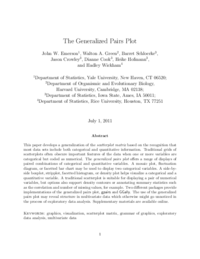The Generalized Pairs Plot

- The Generalized Pairs Plot.
- Journal of Computational and Graphical Statistics, vol. 22, no. 1, pp. 79–91, 2012.
Download: pre-print | from publisher
This article develops a generalization of the scatterplot matrix based on the recognition that most datasets include both categorical and quantitative information. Traditional grids of scatterplots often obscure important features of the data when one or more variables are categorical but coded as numerical. The generalized pairs plot offers a range of displays of paired combinations of categorical and quantitative variables. A mosaic plot, fluctuation diagram, or faceted bar chart may be used to display two categorical variables. A side-by-side boxplot, stripplot, faceted histogram, or density plot helps visualize a categorical and a quantitative variable. A traditional scatterplot is suitable for displaying a pair of numerical variables, but options also support density contours or annotating summary statistics such as the correlation and number of missing values, for example. By combining these, the generalized pairs plot may help to reveal structure in multivariate data that otherwise might go unnoticed in the process of exploratory data analysis. Two different R packages provide implementations of the generalized pairs plot, gpairs and GGally. Supplementary materials for this article are available online on the journal web site.
@Article{gpp,
author = {John W Emerson and Walton A Green and Barret Schloerke and Jason Crowley and Dianne Cook and Heike Hofmann and Hadley Wickham},
journal = {Journal of Computational and Graphical Statistics},
number = {1},
pages = {79–91},
publisher = {Taylor \& Francis Group},
title = {The Generalized Pairs Plot},
url = {http://www.tandfonline.com/doi/ref/10.1080/10618600.2012.694762},
volume = {22},
year = {2012},
bdsk-url-1 = {http://www.tandfonline.com/doi/ref/10.1080/10618600.2012.694762},
}